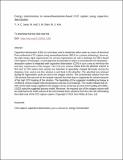| dc.contributor.author | Jande, Yusufu | |
| dc.contributor.author | Asif, Muhammad | |
| dc.contributor.author | Shim, S. M. | |
| dc.contributor.author | Kim, Woo-Seung | |
| dc.date.accessioned | 2020-04-01T11:30:44Z | |
| dc.date.available | 2020-04-01T11:30:44Z | |
| dc.date.issued | 2014-01-07 | |
| dc.identifier.uri | https://doi.org/10.1002/er.3168 | |
| dc.identifier.uri | https://dspace.nm-aist.ac.tz/handle/20.500.12479/703 | |
| dc.description | This research article published by John Wiley & Sons, Ltd., Volume38, Issue12, 2014 | en_US |
| dc.description.abstract | Post‐combustion CO2 capture using monoethanolamine (MEA) is a mature technology; however, the high energy input requirements for solvent regeneration are still a challenge for MEA‐based CO2 capture. In this paper, a novel approach is presented in which a conventional CO2 absorption–desorption system is integrated with capacitive deionization (CDI) in such a way to minimize the heat duty requirement of the stripper. The CO2‐rich solution drawn from the absorber column is first sent to CDI where ionic species are adsorbed at oppositely charged electrodes during the charging cycle, and an ion‐free solution is sent back to the absorber. The adsorbed ions released during the regeneration cycle are sent to the stripper column. The concentrated solution from the CDI process that was sent to the stripper required low heat duty to regenerate the solvent because of the high CO2 loading of the solution. The feasibility of the suggested modelling technique is verified at various stripper inlet temperatures and lean CO2 loadings. The results indicate that 10–45% of the total energy supplied to the stripper can be conserved at a lean CO2 loading of 0.0000–0.0323 using the suggested process model. Moreover, the required size of the stripper column will be small due to the small volume of the concentrated ionic solutions from the CDI cell, eliminating the initial cost of the CO2 capture system. | en_US |
| dc.language.iso | en | en_US |
| dc.publisher | John Wiley & Sons, Ltd. | en_US |
| dc.subject | CO2 capture | en_US |
| dc.subject | Capacitive deionization | en_US |
| dc.subject | Post‐combustion | en_US |
| dc.subject | Energy minimization | en_US |
| dc.title | Energy minimization in monoethanolamine‐based CO2 capture using capacitive deionization | en_US |
| dc.type | Article | en_US |

